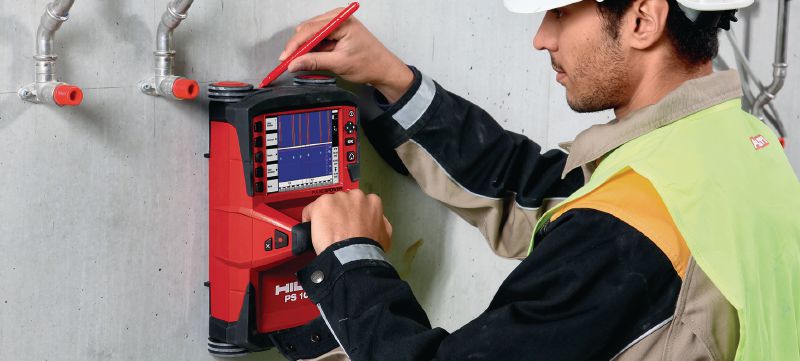Enhance Task Performance with RainierGPR Concrete Scanning Solutions
Enhance Task Performance with RainierGPR Concrete Scanning Solutions
Blog Article
Discovering the Depths: A Comprehensive Overview to Concrete Scanning and Its Diverse Applications
In the realm of building and construction and facilities growth, the careful procedure of concrete scanning holds a critical duty in ensuring the architectural honesty and safety of jobs. As innovation remains to evolve, the applications of concrete scanning have actually broadened far past mere surface-level assessments. From spotting rebar and post-tension wires to drawing up gaps and conduits hidden within concrete structures, the capabilities of modern scanning strategies are both necessary and outstanding. Nevertheless, real deepness of concrete scanning's potential reaches also further, branching right into unexpected industries and stimulating innovative remedies. The interconnected web of possibilities that concrete scanning offers is not just remarkable but additionally crucial for the development of various markets.
Importance of Concrete Scanning
Comprehending the importance of concrete scanning is critical in making sure the safety and security and integrity of frameworks throughout construction and renovation tasks. Concrete scanning uses advanced modern technologies such as ground-penetrating radar (GPR) and electro-magnetic induction to discover ingrained items, gaps, or various other anomalies within concrete frameworks - RainierGPR Concrete Scanning. By conducting extensive scans prior to drilling, cutting, or coring into concrete, building groups can avoid unexpected damage to important architectural components like rebar, channels, or post-tension cable televisions. This proactive approach not just protects against costly repair services and project hold-ups yet likewise enhances general building and construction security by mitigating the threat of structural failings or collapses as a result of compromised honesty.
Moreover, concrete scanning plays a pivotal duty in making sure conformity with building codes and policies that mandate the defense of existing structural components throughout construction activities. By properly mapping out the inner make-up of concrete, scanning modern technologies make it possible for construction experts to make educated choices that support the structural stability and resilience of buildings and facilities projects. In significance, the value of concrete scanning hinges on its capacity to safeguard both the architectural honesty and the workers associated with building undertakings.
Technologies Utilized in Concrete Scanning
Concrete scanning depends on advanced innovations such as ground-penetrating radar (GPR) and electro-magnetic induction to precisely discover ingrained things and abnormalities within concrete structures. Ground-penetrating radar runs by releasing high-frequency electromagnetic waves into the concrete.
Electromagnetic induction, on the other hand, functions by generating magnetic fields around a concrete framework with a transmitter coil. When metal objects are present within the concrete, they disrupt these magnetic fields, creating eddy currents to move through the metal. By gauging the changes in the electromagnetic fields with a receiver coil, the system can determine the place of metallic items in the concrete.
These advanced technologies play a vital function in non-destructive screening, ensuring the security and integrity of concrete frameworks in different sectors.
Applications in Building Market
Within the building industry, concrete scanning technology discovers varied applications that boost job performance and safety and security. Furthermore, concrete scanning is used for locating spaces, such as air pockets or locations of deterioration within concrete, which can endanger the general strength of a framework. Visit Your URL Concrete scanning plays an important duty in quality control by validating the thickness of concrete covers over support, guaranteeing compliance with design specifications and requirements.

Safety Advantages of Concrete Scanning
In the realm of building and construction safety, the execution of concrete scanning modern technology presents a paramount advantage in preemptively recognizing prospective risks and strengthening architectural integrity. By making use of innovative scanning approaches such as ground-penetrating radar (GPR) and electromagnetic induction, building and construction groups can accurately find rebar, post-tension cables, channels, and other covert items within concrete structures. This proactive method dramatically reduces the threat of unintentional strikes throughout boring, cutting, or coring activities, consequently preventing expensive damages, injuries, and project hold-ups.
Additionally, concrete scanning improves employee security by supplying real-time information about the architectural problem of concrete components. By dealing with potential safety worries immediately, concrete scanning contributes to producing a secure working environment and minimizing the likelihood of architectural failures or crashes on building websites.
Future Fads in Concrete Scanning
Emerging advancements in scanning technology are positioned to transform the area of concrete assessment and evaluation. By using the power of AI, these systems can examine vast quantities of data accumulated during scanning procedures to offer more thorough and exact understandings into the condition of concrete frameworks.
Another significant trend is the growth of more user-friendly find out this here and portable scanning tools. Miniaturization of scanning devices enables easier access to confined spaces and remote areas, making examinations extra reliable and thorough. Additionally, advancements in cordless communication innovations make it possible for real-time information transfer and evaluation, promoting quicker decision-making procedures.
Additionally, there is an expanding focus on sustainability in concrete scanning technologies - RainierGPR Concrete Scanning. Producers site are significantly integrating green products and energy-efficient features into their gadgets to minimize environmental influence. These future fads are readied to boost the performance, accuracy, and sustainability of concrete scanning methods, shaping the market's future landscape
Final Thought
In conclusion, concrete scanning plays a vital role in the building and construction industry by ensuring the security and efficiency of different projects. As modern technology advances, the future of concrete scanning holds encouraging advancements for boosting building and construction procedures.

Report this page